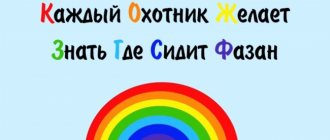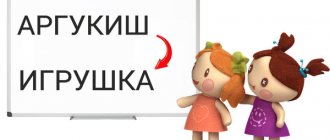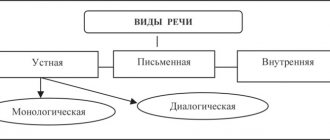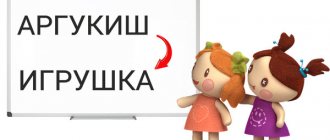Mnemonics for children: tables of numbers, letters, symbols
The simplest method for allowing a child to remember numbers, letters and symbols is a table. You can draw such tables yourself using our tips.
In order to remember numbers, make diagrams by placing numbers and associations to them. Example:
| 1 | Stake, spear, pen, stick |
| 2 | Swan, duck, lantern |
| 4 | Chair, armchair |
| 7 | Hatchet |
To memorize letters, make a similar diagram, only the essence here is slightly different. Place the letters in the first column, and in the second, draw images whose names begin with this letter.
| A | Watermelon, Pineapple, Stork |
| IN | Wolf, Grapes |
| G | Pear, Mushroom |
| M | Raspberries |
| WITH | Sun, Dog |
Mnemonics in kindergarten based on fairy tales: methods for preschool teachers
You can train children’s memory and teach them to retell some texts on a variety of topics even in kindergartens. For this type of mnemonics, teachers, as a rule, use reference diagrams. Learning begins at the age of 1 or 2, when the child is already familiar with some fairy tales and tries to tell them, confusing characters and events. Special mnemonic tables for preschool children are compiled by teachers based on fairy tales known to them.
The images in the table cells are fairy tale characters. A fairy tale called “Kolobok” is quite convenient for such practice. In this table, events are repeated from time to time, and characters change. For children 2 years old, tables consisting of 4 – 9 cells, no more, are suitable.
The following tables are drawn by the teacher and the children. The children will take part in the compilation of such mnemonic tables with great pleasure. In the future, they will independently come up with tables for any fairy tale, complicating them a little, increasing the number of cells themselves.
Memory improvement in this case occurs due to the regular encoding of verbal information into pictures and vice versa. As a result, children scroll through the received material in their heads several times, memorizing it automatically.
For children over 5 years old the task becomes a little more complicated:
- Option 1. The table includes characters from completely different fairy tales. Then the children determine which characters in the table are superfluous.
- Option 2. Fairy tale characters are mixed in the table. Children must distribute these heroes into the correct tables.
- Option 3. The tables are cut, then the children restore them themselves. The cards are scattered, the teacher reads a fairy tale, and the children find the necessary image.
Rules for conducting classes
The process of working and learning with children should be comfortable and beneficial.
- You need to start with simple tasks. First, you can look at cards with single images.
- You should not immediately overload your preschooler; he will quickly get tired and will not absorb the information. You can show no more than two mnemonic tables per day.
- All images of didactic material must be bright and colorful. Children quickly remember colorful images. The grass is green, the carrot is orange, the pine cone is brown, the sea is blue.
- It is worth changing the topic of the lesson every time, otherwise the child will lose interest. Today we are learning poetry. Tomorrow - a fairy tale, wild animals, etc.
- It is important that classes take place only in a playful way.
Using mnemonics to help children memorize multiplication tables
The techniques for learning the multiplication tables are very similar to those used for learning a foreign language. Here you can also use cards by writing numbers on them anywhere.
Currently, the following mnemonics methods are considered quite common:
- Technique with 2, 3, 5. This type of mnemonic technique is used, as a rule, at the initial stage of learning the multiplication table. This counting is considered a basic technique that allows you to become familiar with the multiplication table. This method technologically corresponds to the method during which single-digit numbers and their composition are memorized. If your child can master the material, in the future he will be able to cope with the remaining numbers from the table, as well as more complex options, without any problems.
Learning the multiplication table
- Sequential addition. This method directly deals with the addition of identical terms. It is considered convenient even when multiplying 7 or 8, if, of course, the second factor is small. For example, 5x3=5+5+5.
- Adding a summand number to the previous result. This technique is used if the child has already learned something from the multiplication table. For example, 4. Let's continue the example given above. It's easy to remember. But, if you need 5x6, then you can add the missing 5 to the received answer of 15. 15+5+5+5. In addition, the child must also be able to correctly add and subtract up to 100 in his head.
How to teach a child to remember?
Mnemonics is a technique that makes it easy to remember information. Everyone knows from childhood “ Every Hunter Wants to Know Where the Pheasant Goes ” - the colors - and will be the most common example of mnemonics.
Mnemonics for children - what are the benefits and when to use them?
For schoolchildren and students, the ability to quickly remember a large amount of information is like a super prize in a lottery: reports, poems, essays, speeches at school events, olympiads - it becomes much easier to prepare for them. But besides these obvious advantages, there are also hidden ones:
- Mnemonics are based on associations, so when used, associative thinking develops.
- Mnemonics involves different types of thinking, including logical thinking, as well as imagination.
- Increases vocabulary and coherence of thought.
- Interest in learning appears: when, instead of an hour to memorize the main outline of the text and retell it, the child does it in 10 minutes, it’s hard not to be happy about it.
Mnemonics is based on remembering information through associations, so you can safely start classes from 2-3 years old. Already in kindergarten, a child is able to retell the meaning of “The Ryaba Hen” thanks to pictures - this is one of the techniques: the use of mnemonic tables (pictures). Mnemonic tables are effective for children because at this age their memory is visual: they remember what they see. Therefore, it is difficult with children to learn something that is not visually reinforced. The older the child gets, the more memory methods can be used.
Mnemonics: 3 main ways to memorize
1. Mnemotables. The method is suitable for children and primary schoolchildren, when the amount of information is not as large as in middle school. The method is suitable for literature lessons and working with text, memorizing poems and songs in music lessons, etc. Mnemonic tables are diagrams with symbols (pictures, letters, etc.) located on them, in a certain order. How to work with a child? Start your lessons with fairy tales known to your child. Print out the pictures or take them from a children's book, arrange them in a chaotic order, and ask your child to collect them in the correct sequence. If the child cannot cope, help with leading questions. After this, ask them to retell the plot of the fairy tale, based on the images. Over time, complicate the tasks: longer texts, more intricate plots, it is good for the child to come up with and draw pictures, which will then help him when retelling the text. When memorizing poems, there should be one picture-image for each line. Mnemonic tables are also suitable for memorizing large texts; in this case, the text is divided into a plan and each of its points is given 1 large association picture. This picture may contain the meaning of the entire paragraph.
2. Poems/rhymes. This method is great for learning rules, procedures, etc. Poems themselves are already one of the techniques of mnemonics, which is based not only on association, but also on hearing. Examples from the rules of the Russian language:
We ate cake for a long time. Shorts didn’t fit!
Such techniques are used not only in the Russian language, but are also common in other disciplines, for example, in geometry: A bisector is a rat that runs around the corners and divides the corner in half!
In this method, it is not necessary to use already existing memory rhymes; you can come up with your own.
3. Roman Room Method or Cicero Method. It is generally accepted that Cicero never used any notes during his speeches, and delivered his speech solely from memory. The secret is simple: Cicero, walking around his own house, “attached” the topics of his report to things. This is somewhat reminiscent of an adapted “cross on your hand so as not to forget” method. So, when Cicero spoke, he mentally returned to his house and, using its image and associations, reconstructed the plan of his story. Cicero's method is perfect for schoolchildren when defending essays, reports, or when retelling a historical event or a writer's biography. The bottom line: the child must attach images to a place that is familiar to him. For example, his bedroom or school office. We select 1 wall, look at what is located on it (we go either from top to bottom or from right to left): a bookcase with books, a picture, a board, a pointer, a flower. For each subject in order, we attach the plan of our story (or the material that you want to remember). A cabinet with books - the date of birth and death of the writer, his family - each book is a separate person: mother, father, brother, sister; the picture is the writer’s childhood, etc.
Mnemonics with its methods of memorization are suitable for children and adults; they will help you prepare perfectly for a performance or simply memorize a poem, and will also help increase your memory, vocabulary, and the logic of speech.
Our online classes will also help in developing the memory of preschoolers and primary schoolchildren.
The use of mnemonics in speech therapy sessions with children
Preschool age is considered the most favorable, since during this period of a child’s life the foundations of literacy, clear pronunciation of words, and beautiful speech are laid. These are very important conditions that influence the mental education of a child. A child with speech impairment has the following problems:
- Minimum set of words.
- Inability to form sentences from words.
- Impaired pronunciation of certain sounds.
- Disturbed attention.
- Broken logic.
When faced with such a problem, you can use mnemonics. Thanks to it you will achieve the following results:
- The child’s connected speech and associative thinking will improve.
- The child will be able to better assimilate the material using visual and auditory memory.
- The child’s imagination will work better and the process of memorizing sounds will speed up.
Mnemonic squares are an ideal method, a symbol of any successful lesson. Thanks to such schemes, you will quickly teach your child to learn poems, riddles, and tongue twisters.
Mnemonics in the classroom
The stages of study are:
- Read the poem expressively to your child.
- Ask your child to learn the verse with you.
- Read the poem again, focusing on the mnemonic table.
- Ask your child questions about the verse. Help him if necessary, clarify with him the main idea of the work.
- Find out from your child exactly which words seemed incomprehensible to him. Explain what they mean.
- Read each line of the verse separately. Ask your child to repeat the verse.
- At the very end, the child will have to recite a poem.
In the mnemonic table that you will use, enter all the characters in the verse. Thanks to this, your baby will learn to concentrate, construct sentences correctly and express his own speech.
Exercises for preschoolers
Preschool age is considered a favorable period for laying the foundations of competent, clear, beautiful speech. Mnemonics for beginners (simple, fun tasks, games) will help your child’s speech develop faster. It is useful for the development of the articulatory apparatus to perform tasks using onomatopoeic words. They correct diction well - pure jokes (“If only there was smoke coming out of the chimney”), nursery rhymes, phrases containing a certain group of sounds (“Sanya’s sleigh rides on its own”).
Exercises on the pronunciation of hissing sounds can be combined thematically.
After looking at the picture “Hedgehog and Hedgehogs,” the adult offers to complete a number of tasks. The child must clearly pronounce phrases with the sounds “sh” and “zh”. “Sha-sha-sha - we walk slowly; shu-shu-shu - I’ll give the baby a raspberry; shi-shi-shi - where the kids walk.” Such exercises help you master question intonation and develop a sense of rhythm.
By isolating the sound while clearly pronouncing a word, the skill of understanding the terminology “sound” and “word” is developed. When working with children, it is necessary to emphasize the development of intonation sense, rate of speech, diction, and strength of voice. Games can help with this.
Exercises for beginners:
- "Whose voice is this ? The goal of the game is for the child to learn to recognize adult animals from young animals by the reproduced sound. For such a game, you can take figurines of a dog and a puppy, a duck and a duckling, a cat and a kitten. Alternatively, you can sculpt animals from plasticine or use cards. The plot of the game: animals come to visit the baby, they want to play with him. Children should understand the difference between how a mother cat meows and how her baby meows.
- Game "Compare the cubes" . The task is to teach the child to correlate objects with different characteristics. An adult offers to look at two cubes and tell how they differ. The kid takes one cube and says that it is big, and the second cube is small. The first cube is red and the second is white. The red cube is plastic, the white cube is made of fabric and is soft inside.
- Game “Compare two kittens” . The child is asked to look at the kittens. One of them is white and large, and the second is black and smaller. You need to say who they are. Come up with names for them so that it is clear that one kitten is black and the other is white. What is the difference.
- Game “What little animals can do . The goal of the game is to choose verbs that denote the characteristic actions of animals. An adult shows pictures of animals, and the child must say what they can do or what they say. For example, a cat loves mice. She loves to meow. The dog loves to bark and eat bones, run and jump. The cockerel crows and loves to peck grains.
- Game "Profession" . Here you will need cards that depict people of different professions (pilot, hairdresser, doctor, cook). An adult asks who heals people. The kid must answer correctly. This is how the remaining cards are played.
- The game “Wizards” helps expand vocabulary, develops long-term memory and logical thinking. You will need cards with images of individual objects - a table, an apple, a door. The adult names several words, and the child must choose those cards that will help him remember the named words. He kind of “bewitches” them into these cards. Then the baby takes the cards and with their help remembers the named words. The game is aimed at understanding the logical connections between objects.
Regular playful activities help to awaken interest in words. The exercises prepare children for further independent compilation of narratives, stories, texts, and form connected speech.
Mnemonics for learning vocabulary words: techniques, word associations
To study vocabulary words, the following types of mnemonics are used:
- Visual associations.
- Sound associations.
- Mnemonics of “connections” and many others.
Children like visual associations the most. While memorizing a certain word, invite your child to look at a picture that will represent the word, plus he will be able to play with a letter that is difficult to remember. For example, draw the word “Magnet” and the letter “A” in the picture. When choosing other words, focus on those letters that your baby cannot say or write.
Also, in other words, depict the letters that cause difficulties for the child while writing with pictures, taking into account the meaning of the word itself. In the word “Kopeyka” the second letter is very similar to a penny. Therefore, draw her instead.
The next technique is sound associations. For example, the word “Breakfast” is similar to the word “Cancer”. By combining these words into one single phrase, you can get the sentence: “ There will be boiled crayfish breakfast .” Your child will learn this word using sound association. And the phrase itself sounds more melodic, therefore, it is remembered without problems.









